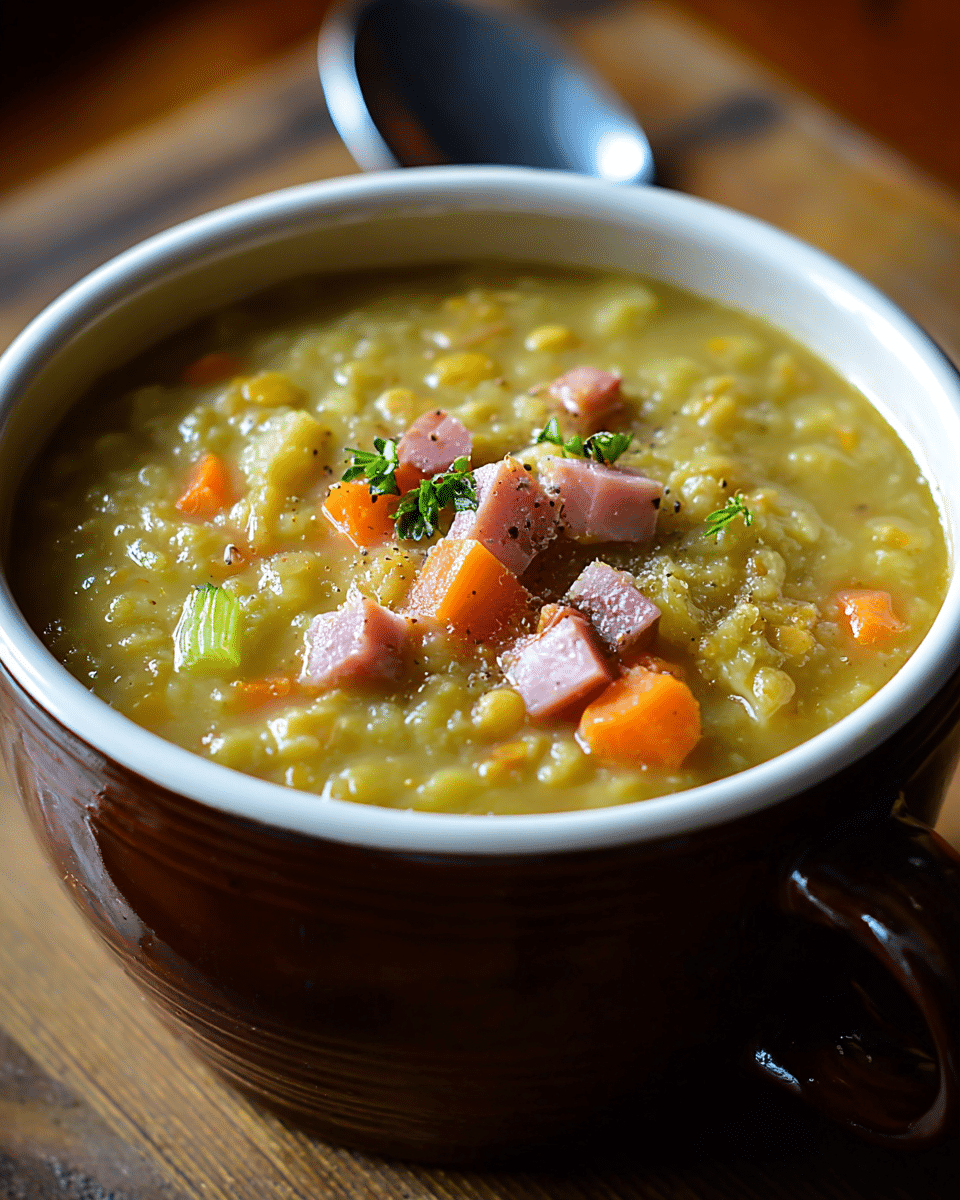The comforting aroma of split peas slowly simmering with a smoky ham bone is one of those timeless kitchen moments. This recipe doesn’t rely on fancy ingredients or trendy twists it’s pure, old-school nourishment. With every spoonful, you get creamy peas, tender vegetables, and that rich, meaty flavor from the ham bone that makes it unforgettable.
Perfect for a make-ahead meal or a quiet dinner on a chilly night, this dish captures everything you love about homemade soup. It’s wholesome, satisfying, and feels like a warm hug in a bowl. Just add some crusty bread and you’ve got yourself the coziest meal ever.
Full Recipe:
Ingredients:
-
2 ¼ cups dried split peas
-
2 quarts cold water
-
1 ham bone (with or without leftover meat)
-
2 onions, chopped
-
3 carrots, diced
-
3 celery stalks, chopped
-
1 large potato, peeled and diced
-
½ teaspoon dried marjoram
-
Salt and pepper to taste
Directions:
-
Rinse split peas thoroughly and soak in cold water for 1 hour. Drain and rinse again.
-
In a large stockpot, combine split peas, 2 quarts of cold water, ham bone, onions, marjoram, salt, and pepper.
-
Bring to a boil over medium-high heat.
-
Reduce heat and simmer uncovered for 90 minutes, stirring occasionally.
-
Remove the ham bone, strip any meat, chop it, and return the meat to the pot.
-
Add carrots, celery, and potato.
-
Continue cooking for 30–40 minutes, until vegetables are tender and the soup is thickened.
-
Adjust seasoning with salt and pepper. Serve hot.
Prep Time: 20 minutes | Cooking Time: 2 hours | Total Time: 2 hours 20 minutes
Kcal: 320 kcal | Servings: 8 servings
The Timeless Comfort of Split Pea Soup with Ham Bone
Few dishes embody warmth, resourcefulness, and tradition like a bowl of Split Pea Soup with Ham Bone. This rustic, satisfying soup has a long-standing place in culinary history, evolving through centuries and across continents to become the cozy, nutrient-rich comfort food we know and love today. From its humble ingredients to its deeply nourishing flavors, this soup tells a story that stretches far beyond the kitchen and into the heart of generations past.
Whether you’re using a leftover ham bone from a holiday roast or seeking a way to turn pantry staples into something memorable, Split Pea Soup delivers. It’s not just a meal it’s a method of honoring traditions, minimizing waste, and creating something wholly nourishing.
Historical Roots: A Soup with Global Origins
Split Pea Soup has deep roots in human civilization, dating back thousands of years. Peas were cultivated in the Mediterranean region as early as 6000 BCE, and ancient Greek and Roman societies commonly consumed them in stews and soups. During the Middle Ages, dried legumes were a key staple throughout Europe due to their long shelf life and high nutritional value. Peas could survive harsh winters and provide sustenance when fresh produce was scarce.
One of the most iconic cultural versions comes from the Netherlands “Erwtensoep” or “Snert” a thick, stick to your ribs pea soup traditionally made with split peas, pork, and root vegetables. Scandinavians, Germans, and Eastern Europeans have their own hearty variations, often built around smoked meats and slow cooking.
When these European traditions came to North America through immigration, the recipes adapted to local ingredients and customs. In the U.S., particularly, using leftover ham bones from large Sunday or holiday meals became a brilliant, budget-conscious way to extract every bit of flavor and value from the meat. Over time, it became a beloved staple of home cooking.
The Flavor Profile: Deep, Savory, and Soul-Satisfying
What makes Split Pea Soup with Ham Bone so special is its complex yet comforting flavor profile. The star of the show is the split peas which, when simmered slowly, break down into a creamy, velvety base that thickens naturally. Their mild, slightly nutty flavor acts as a blank canvas that absorbs the savory depth from the smoked ham bone.
The bone itself is crucial not only for the flavor it imparts, but for the collagen and richness it releases during long, slow cooking. Any bits of meat clinging to the bone become tender and flavorful, creating a texture contrast that keeps every spoonful interesting.
Then come the aromatic vegetables: onions, carrots, celery, and often potatoes. These don’t just add bulk; they contribute layers of sweetness, earthiness, and body. Herbs like marjoram or thyme introduce gentle herbal notes that round out the soup’s flavor.
Together, these elements create a soup that’s rich without being heavy, hearty without being cloying, and soothing in a way that lingers long after the bowl is empty.
A Nutritional Powerhouse in a Bowl
One of the most underrated aspects of Split Pea Soup is its nutritional value. Despite its comforting, homey character, it’s surprisingly healthy:
-
High in fiber: Split peas are loaded with dietary fiber, promoting digestion, satiety, and stable blood sugar levels.
-
Rich in plant-based protein: Just one serving offers a significant protein punch excellent for vegetarians who may opt for meatless variations.
-
Low in fat (depending on preparation): While ham provides protein and flavor, the soup itself is not inherently fatty or indulgent.
-
Packed with vitamins and minerals: Carrots contribute vitamin A, potatoes offer potassium, and peas deliver iron, magnesium, and B vitamins.
For those looking for wholesome, real-food meals that don’t rely on processed ingredients, this soup is a winner. It can also be made gluten-free and low-sodium with minimal adjustments.
Tips for a Perfect Pot of Split Pea Soup
Although the recipe is simple, a few techniques can elevate it from good to unforgettable:
-
Use a meaty ham bone: Don’t skimp bones with attached meat add richness and depth. Leftovers from a glazed holiday ham work beautifully.
-
Soak your split peas: While not always required, soaking them for an hour helps reduce cooking time and ensures even texture.
-
Don’t rush the process: Split pea soup benefits from a long simmer. Low and slow helps develop that signature creamy consistency.
-
Add vegetables in stages: Onions can go in early, but hold off on carrots, celery, and potatoes until later so they don’t turn mushy.
-
Season at the end: Ham can be salty, so wait to adjust your seasoning after the flavors have melded.
Variations to Explore
One of the best things about this dish is its flexibility. You can tweak the basic idea to suit your tastes, dietary restrictions, or pantry situation:
-
Vegetarian/Vegan Version: Omit the ham bone and use smoked paprika or liquid smoke to replicate that depth. Use vegetable broth for added flavor.
-
With Bacon or Sausage: If you don’t have a ham bone, sauté bacon or smoked sausage as a flavor base.
-
Spicy Split Pea Soup: Add red pepper flakes, hot sauce, or diced jalapeños for a warming kick.
-
Grain Boost: Add barley or brown rice halfway through for added texture and nutrition.
-
Herb Alternatives: Experiment with thyme, bay leaves, or rosemary in place of or alongside marjoram.
Storing, Freezing, and Reheating
Split Pea Soup with Ham Bone is one of the most meal-prep friendly dishes out there. It stores beautifully and often tastes even better the next day.
-
Refrigerator: Store in airtight containers for up to 4–5 days. The soup will thicken, so reheat with a splash of broth or water.
-
Freezer: Freeze in individual portions for up to 3 months. Make sure to cool the soup completely and leave space in containers for expansion.
-
Reheating: Gently warm on the stovetop or microwave, adding liquid as needed to loosen the consistency.
Serving Suggestions: What to Pair It With
Though hearty on its own, Split Pea Soup becomes even more satisfying when paired with the right accompaniments:
-
Crusty Bread: Rustic sourdough or a slice of cornbread is perfect for dipping.
-
Cheese Toast or Grilled Cheese: A sharp cheddar sandwich alongside adds richness.
-
Light Green Salad: Arugula or spinach with lemon vinaigrette balances the heaviness.
-
Pickled Veggies: Pickled onions or beets add an acidic contrast that cuts through the soup’s richness.
-
Wine Pairing: Try a dry white wine like Sauvignon Blanc, or a medium-bodied red like Pinot Noir.
Conclusion:
Split Pea Soup with Ham Bone is more than just a comforting meal it’s a dish rooted in tradition, thrift, and timeless culinary wisdom. It’s proof that the best food doesn’t require extravagant ingredients or elaborate techniques. Instead, it invites us to slow down, make the most of what we have, and savor the deeply satisfying process of creating something from scratch.
Its versatility, health benefits, and incredible flavor make it a staple in many kitchens. Whether you’re stirring a pot for the first time or continuing a family legacy, this soup promises to deliver warmth, comfort, and nourishment in every spoonful.
So next time you find yourself with a leftover ham bone or just a craving for something soulful, let this humble bowl of green gold goodness remind you that simple food really is the best kind.






